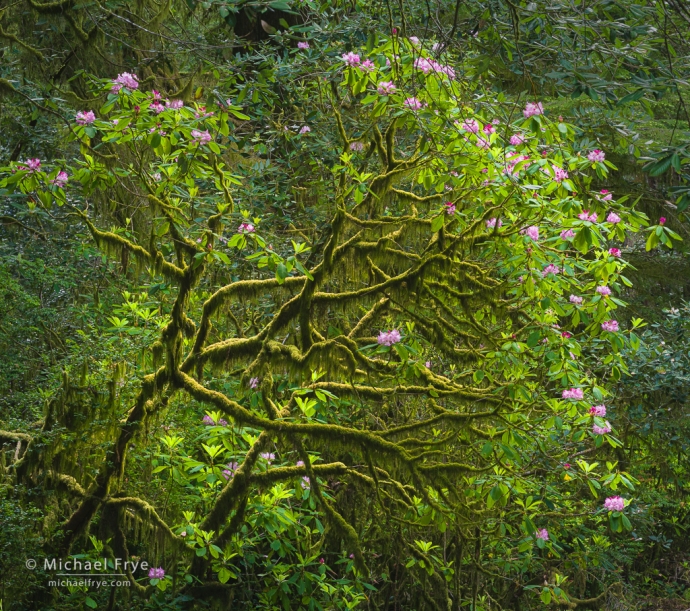
Lichen-covered rhododendron, Northern California. This was an overcast day, and the soft, even light helped simplify this complex scene, and emphasize the color contrasts between the pink rhododendrons and various shades of green. I used a long lens to isolate the rhododendron against a dark, leafy background. Moving closer with a shorter lens would have required looking up at the top of the tree, forcing me to include bright, distracting patches of sky. 159mm, 1/4 sec. at f/16, ISO 800, polarizing filter to cut reflections on the leaves.
Forests can be challenging to photograph. They’re beautiful, but cluttered, and often visually chaotic.
Creating order out of that chaos requires finding ways to simplify things. That’s one of the reasons fog is so helpful for these scenes: it obscures the background, reducing the clutter. (It also lends a wonderful atmosphere to the photographs.)
During our recent workshop in the redwoods we did get some fog, and even sunbeams. I’m sure I’ll post some of those photos down the road.
But there were also many occasions before, during, and after the workshop when we didn’t have fog, and I was photographing forests in soft light, or with sunlight filtering through the trees. What then?
Under those conditions I tend to narrow my view, and focus on smaller parts of the forest in order to simplify the compositions. I look for small, interesting vignettes instead of trying to show a big swath of trees.
Sunlight in a forest creates random, splotchy patterns of light and dark that often add to the visual complexity of a scene. But sometimes you can make those spots of light work for you. In those conditions, I look for places where a spot of sunlight is hitting something interesting, and then try to build a composition around that visual focal point.
You can’t fight the light. If you find an interesting subject, but it’s in the shade, and there’s something brighter next to it or behind it, the viewer’s eye will get drawn to that brighter spot, rather than your subject. You’re setting up a visual tug of war, and your photograph will be the loser.
Instead, I try to find an eye-catching object lit by the sun, and make that the visual focal point of the image. If I can create a light-against-dark juxtaposition, with that sunlit spot surrounded by darker, shaded areas, then the viewer’s eye is drawn right to where I want it to go, and I can make that splotchy light work for me, rather than against me.
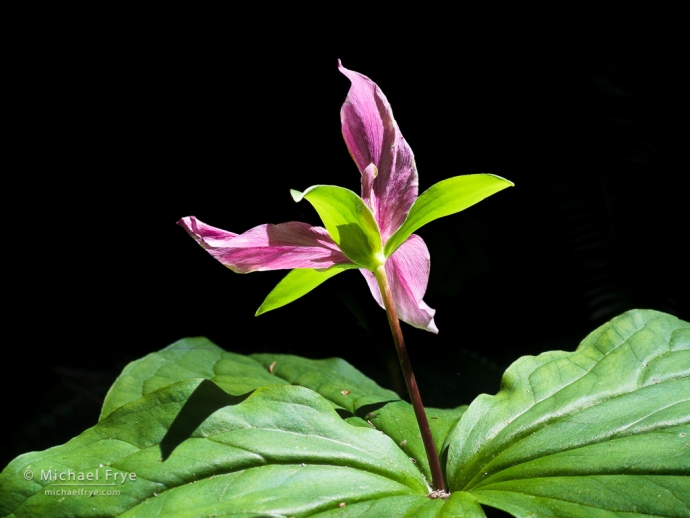
Trillium flower, northern California. This was a simple, clean, light-against-dark juxtaposition, with the trillium lit by the afternoon sun, and the background in shade. I made this while scouting before the workshop, and only had my iPhone with me, but I didn’t mind that, as I can capture a high-quality raw image with the phone. And as it happened, the light would have changed long before I would have been able to set up my big camera on a tripod to capture this scene. iPhone 12 Pro Max with 2.5x lens (equivalent to about 65mm on a full-frame sensor), 1/180 sec. at f/2.2, ISO 20.
You could find an interesting subject, then wait and hope the sun will hit it. But you could wait a long time. Maybe all day. I find it more productive to wander down a trail, find a spot where the light is striking something interesting, then move quickly to compose and capture the photograph before the light changes. Sometimes I’m too late, but I definitely have more success with that approach than with waiting.
With soft light (shade or overcast), the even lighting is actually freeing, allowing me to build a composition around almost anything that catches my eye, knowing that it won’t be competing with a brighter, sunlit spot. But under those conditions the sky is much brighter than the trees or forest understory, so including the sky sets up another visual tug of war.
The challenge then becomes finding compositions that don’t include any sky. That often means featuring only the bases of the trees, or using a solid background filled with trunks or leaves. It also helps to find elevated vantage points where you can look down toward the ground, or across a swale toward another hillside, rather than up toward the sky.
In either situation – with soft light or spots of sunlight – I’m often using telephoto lenses to isolate small, interesting parts of the forest. A long lens narrows the angle of view, and makes it easier to keep the sky out of the frame, or zero in on a spot of sunlight striking one particular trunk, or cluster of leaves, or patch of ferns. Again, it’s about keeping the compositions as clean and simple as possible, and narrowing the angle of view helps to accomplish that.
Here’s a small portfolio of forest images I made during our recent trip to the redwoods. None of them include fog, so I worked with either soft light or patches of sunlight. I’ve included extended captions to help explain my thought process behind each photo.
— Michael Frye
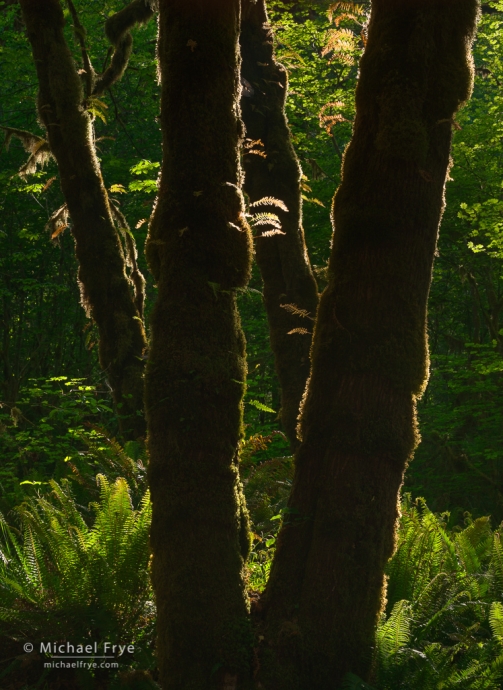
Big-leaf maple trunks with ferns and moss, Northern California. Before our workshop I noticed these beautiful backlit ferns at our campsite. I used a short telephoto lens to isolate just the essentials of this scene. 91mm, 1/6 sec. at f/16, ISO 100, polarizer.
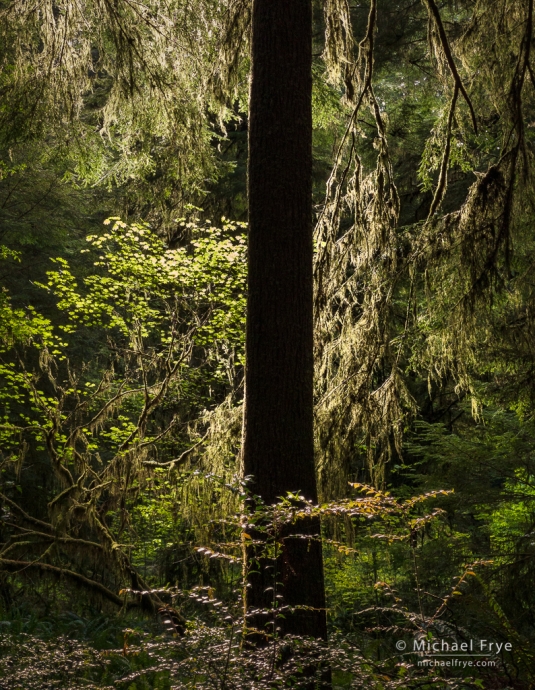
Young redwood, northern California. The beautiful backlit leaves and lichens against a dark background caught my eye. Again, I made this image with my iPhone while scouting. iPhone 12 Pro Max with 2.5x lens (65mm equivalent), 1/120 sec. at f/2.2, ISO 40.
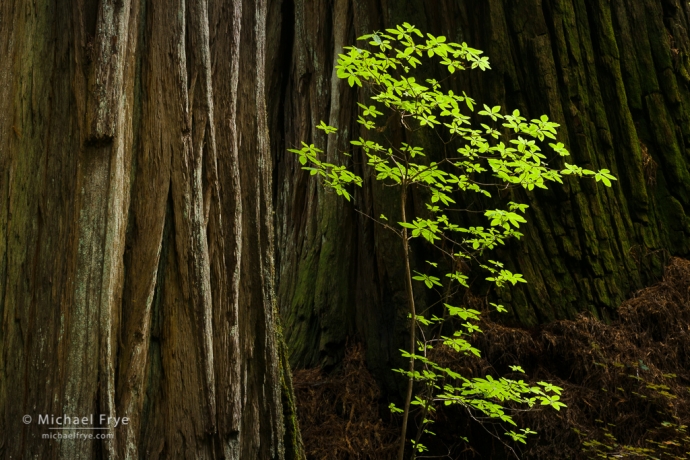
Mock azalea against a redwood trunk, northern California. The skies were thinly overcast, so you could say there was soft sunlight in this scene. But again this light-against-dark juxtaposition caught my eye, and I used a short telephoto lens to pare the composition down to the essentials. 87mm, 1/3 sec. at f/16, ISO 400, polarizer.
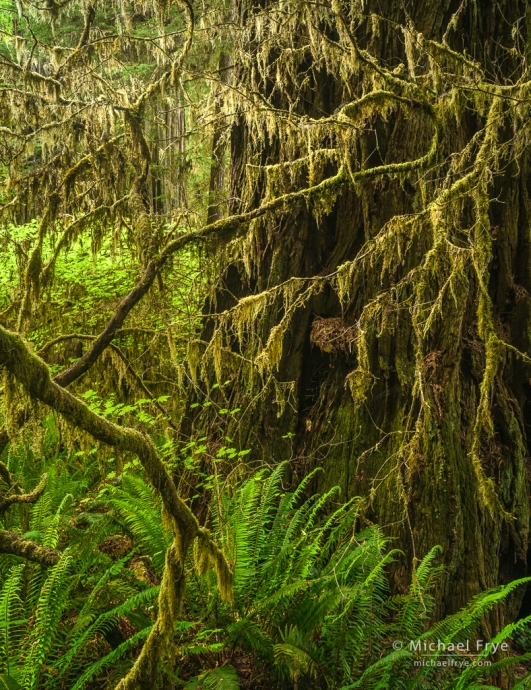
Ferns and lichens in a redwood forest, northern California. Overcast skies again, but the soft light had some direction, spilling into the scene from behind and highlighting the hanging lichens. This time I used a wider lens to fit everything in, but got the camera up as high as I could on my tripod and pointed it down to keep patches of bright sky out of the frame. 32mm, 1/2 sec. at f/16, ISO 500, polarizer.
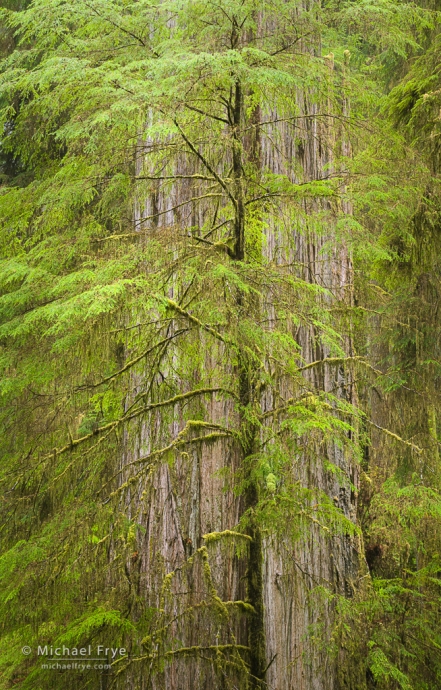
Yound and old redwoods, northern California. Soft light was perfect for bringing out the subtle colors in this scene. The camera was pointed toward a hillside, which kept distracting patches of sky out of the background, and I used a telephoto lens to distill the composition down to the essentials – the feathery leaves of a young redwood against the massive trunk of an ancient redwood. 113mm, 2/3 sec. at f/11, ISO 800, polarizer.
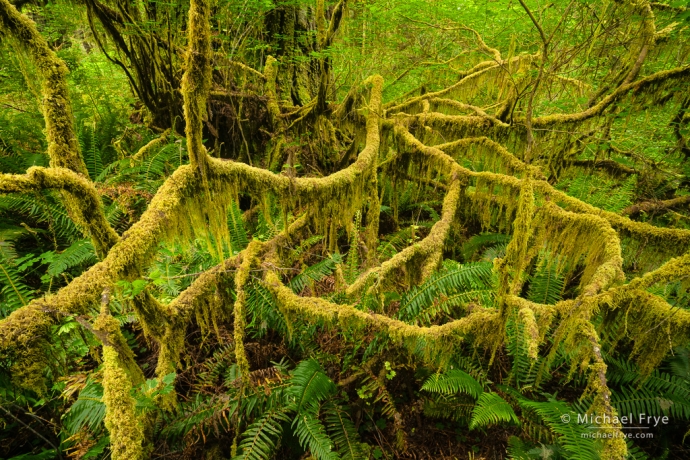
Lichen-covered maple branches in a redwood forest, northern California. With soft, overcast light I knew I had to keep bright patches of sky out of the frame, so I raised the tripod as high as I could and pointed it down, using my widest lens to include all of this pattern. 16mm, 1/3 sec. at f/16, ISO 1600, polarizer.
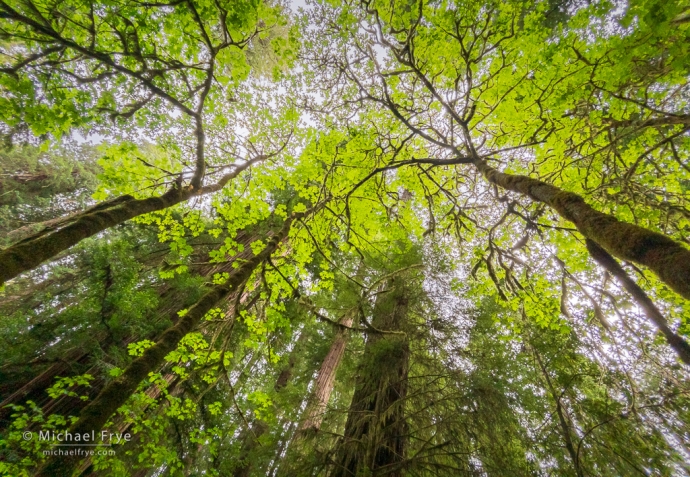
Maples and redwoods, Northern California. I broke my own rule here, and pointed the camera up toward a bright, overcast sky. But I liked the glowing, softly-backlit maple leaves, and figured I could live with the bright sky. I used my iPhone again here, with its ultra-wide lens (on a tripod), because that lens is wider than anything I have for my big camera. iPhone 12 Pro Max with 0.5x lens (13mm equivalent), HDR bracket using the Lightroom camera app, f/2.4, ISO 32.
Related Posts: Return to the Redwoods; Simple and Complex; Photographing Forests
Michael Frye is a professional photographer specializing in landscapes and nature. He is the author or principal photographer of The Photographer’s Guide to Yosemite, Yosemite Meditations, Yosemite Meditations for Women, Yosemite Meditations for Adventurers, and Digital Landscape Photography: In the Footsteps of Ansel Adams and the Great Masters. He has also written three eBooks: Light & Land: Landscapes in the Digital Darkroom, Exposure for Outdoor Photography, and Landscapes in Lightroom: The Essential Step-by-Step Guide. Michael has written numerous magazine articles on the art and technique of photography, and his images have been published in over thirty countries around the world. Michael has lived either in or near Yosemite National Park since 1983, currently residing just outside the park in Mariposa, California.









Very helpful tips for photographing forests. Thank you. Great photos too.
Thank you Kate!
Nice you see the photos you captured and your thought process behind each.
Thanks Lawrence – glad you found this helpful.
Thank you so much for this illuminating article (pun intended!) It was so helpful to read about your thought process, especially regarding the aspect and choice of lens. The iphone photography was a lovely surprise.
Nice pun Sarah, and thanks!
Yes, very helpful, as always! Great photos, too!
Ha, misspelled my own name — Ediger.
Well that can happen. 🙂
Thank you Warren!
The rhododendron at top is definitely a best of 2022! Thanks for sharing.
Thanks very much Rhoda!
Here in the Northeast, making compositional sense of dense forest can be challenging even aside from the light, and I do find myself experimenting with different ways of dealing with the light challenges depending on what they present on any given day. Thank you so much for this helpful article on this topic.
Glad you found this helpful Nancy. Are you familiar with the book “Order Out of Chaos” by Robert Glenn Ketchum? I’m sure it’s long out of print, but it’s a beautiful book of Ketchum’s photographs of Northeastern forests. The title is an apt description of the challenge of photographing those forests.
Robert Glenn Ketchum’s website has some of the photos from “Order Out of Chaos.” Gives a great overview of his photographs of forests. Amazon doesn’t list this particular title, although it has other books of his.
Thanks for pointing this out Mike. I don’t have the book, unfortunately, so it was good to see some of those images again.
I’d like to see the Lightroom edits on the first image with the rhododendron;)
Well there’s not that much to it. Mostly basic stuff like adding contrast, adjusting white balance, edge darkening, and so forth.
I love the photo of the young redwood you photographed with your iPhone. This was a great tutorial and reminder to think about using the long lens!
Thanks Vivienne! There’s a lot you can do with the phone camera.